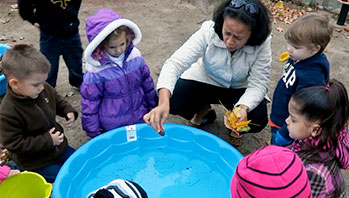- clipboard
- marker
- paper
- tape and/or video recorder
- listen
- louder
- predict
- quiet
- softer
- sound
- source
MA Standards:
Language/L.PK.MA.6: Use words and phrases acquired through conversations, listening to books read aloud, activities, and play.
MA Draft STE Standards:
Physical Sciences/Matter and Its Interactions/Properties of Matter PS1.B: Differentiate between the properties of an object and those of the material of which it is made in science explorations and activities such as art and music.
Head Start Outcomes:
Logic and Reasoning/Reasoning and Problem Solving: Recognizes cause and effect relationships.
Logic and Reasoning/Reasoning and Problem Solving: Classifies, compares, and contrasts objects, events, and experiences.
PreK Learning Guidelines:
Science and Technology/Technology and Engineering 23: Explore and describe a wide variety of natural and man-made materials through sensory experiences.
Explore Together (outdoors): Listening Walk

© Commonwealth of Massachusetts, Department of Early Education and Care. All rights reserved.
STEM Key Concepts: Sounds have a source; Different objects make different sounds; Sounds vary in three ways: volume, pitch, and timbre; A sound becomes louder when the force of the action that is creating the sound is increased; A sound becomes softer, or quieter, when the force is decreased
ELA Focus Skills: Speaking and Listening, Vocabulary
Tell children they are going to go outside for another listening walk. Bring a clipboard to record children’s ideas and a tape and/or video recorder for children to record the sounds they hear.
Gather children outside in a circle. Say, Let’s be quiet so we can listen to the sounds around us, just like the girl in the book The Listening Walk that we read last week. Let’s try closing our eyes so we can listen carefully to sounds without looking around. Give children time to listen quietly. Then ask questions such as,
- Can you name one sound you hear? Can you describe the sound?
- What object do you think is making the sound? How do you know what object is making the sound?
- Ask children to become “sound detectives” and follow a sound to its source (if possible). Listen for a sound and then ask, What do you think will happen as you get closer to the sound? (becomes louder)
- Why do you think a sound might become softer as you are following it? (the source is farther away)
- Listen for a sound whose source might change its location. (bird, frog, car) Ask, What do you predict will happen to the sound if the <bird> flies farther away? (become softer)
Encourage children to record other children while they are tracking the source of a sound.
Reflect and Share
When you are back inside, ask children to share what they observed about sounds and how they followed each sound.
- If you have recordings of the sounds or of children following the sounds, play them as children describe their observations.
- Encourage children to move closer to or farther away from the recorder to demonstrate what happens to sounds.
